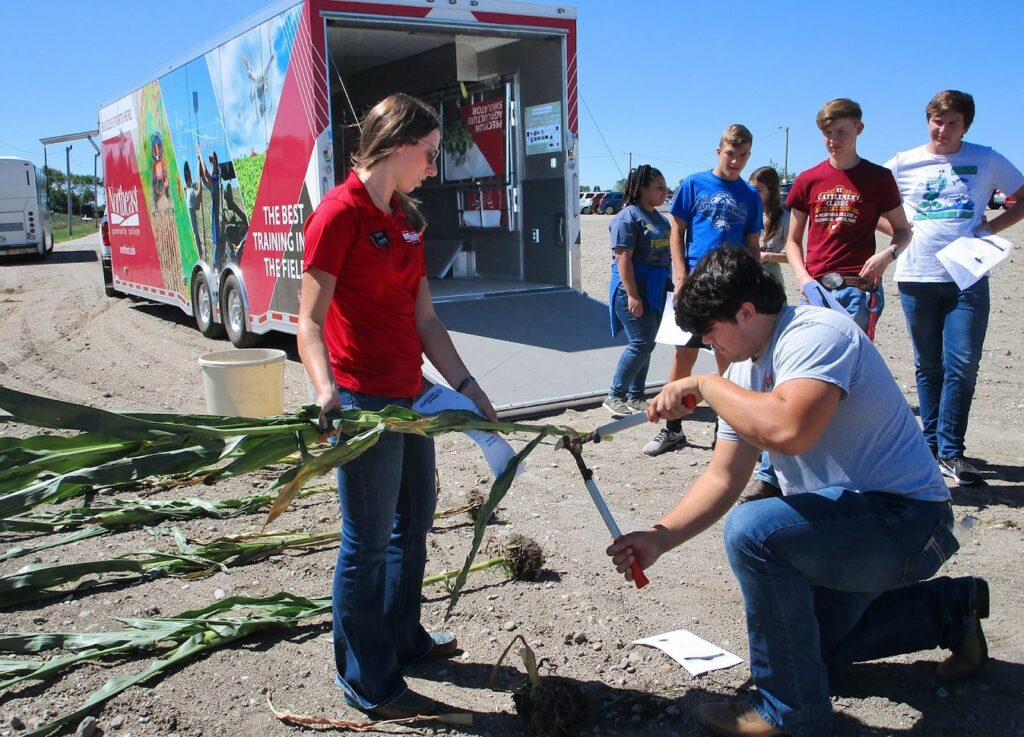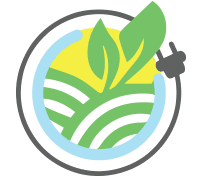Northeast Precision Agriculture Trainer Brings the Classroom to High School Students

October 27, 2022
NORFOLK, Neb. – An apple may not be the first thing that comes to mind when one thinks of precision agriculture. However, the piece of fruit can clearly illustrate to young people how technology behind precision ag is necessary to continue to feed a world population that now totals nearly eight billion people.
Courtney Nelson, precision agriculture trainer at Northeast Community College, conducts an activity with junior high and high school students where she cuts an apple into quarters and then removes three of them because they represent water such as oceans, lakes and rivers. She then cuts the remaining quarter into tiny pieces.
“In the end I am left with the outer rind of 1/32nd of the apple,” Nelson said. “I tell them, ‘This is the five feet of the earth’s arable land that we get to use. We started with this whole apple and this little sliver is the amount of land we have to feed the world. We need to be intentional with what we do with it.’”
Her lesson emphasizes that with such a small amount of land, society needs to continue to figure how best to keep producing and optimize results with less inputs. And it is with good reason; the world’s population is expected to jump to nine billion people in less than 30 years.
In her role as precision agriculture trainer at Northeast, Nelson’s job is to bring her classroom to communities across Northeast’s 20-county service area. She defines precision agriculture to the students as a farm-management method – a way of looking at fields and data to be very intentional with decision-making. Technology such as machinery, maps, software, and drones are among the tools that are available to help make management decisions.
In 2018, Northeast received a three-year, $785,000 grant through the National Science Foundation to fund the program and hire a trainer. In 2021, the CHS Foundation awarded the College a three-year, $250,000 grant to continue to showcase precision agriculture to junior high and high school students.
“I attended a conference where they revealed that students decide if they’re going to be interested in STEM (Science, Technology, Engineering, and Math) by the age of 12. With that in mind, we are attempting to interact with junior high students in addition to our original high school audience,” Nelson said. “I am using revamped curriculum that was developed during our first grant. We have an introductory model providing a 10,000-foot overview of what precision agriculture is. I also have modules that dive deeper into certain topics such as soil health, mapping, and nutrient management with hands-on activities.”
Part of the first grant was used to purchase a Precision Agriculture Learning (PAL) mobile classroom, which is housed in a customized trailer that is taken to educational trainings and events across the 20-county region. It includes materials to provide hands-on learning experiences within the classroom. The mobile classroom has also been taken to county fairs and other events, such as Husker Harvest Days near Grand Island, over the past several months.
Nelson said the PAL includes space to bring new equipment and bigger “wow factor” items to classrooms, school visits and other events.
“We’re really growing that space and redefining what that simulator can do for us. We have ordered some GPS simulators so we can take our small tractor to schools and let students practice auto steer and things like that,” she said. “It gives us a chance to showcase topics with bigger models for adults and children all in the same space. The adults learn things through planting simulations, while kids can play with some of the farm toys.”
Like the apple, Nelson has another activity for students that focuses on erosion. After glitter is placed on a table-top field to represent fertilizer application on a field, water is poured onto the model to simulate rain or an irrigation system.
“The table model slopes down and all this glitter – this nitrogen – gets into their water and (the students) say, ‘Well, it’s no big deal. It’s only like 10 glitter flecks.’ But then I explain how that even 10 glitter flecks can begin to impact human health and animal health in a lot of different ways. And then they always say, ‘Oh, it’s a bigger deal than I realized.’”
Nelson did not know what she wanted to pursue as a career when she was in junior high school. After becoming involved in FFA, she pursued a path in agriculture when she got to college. It then developed into a passion of working to protect the environment.
“I enjoy having clean water for us to drink. I enjoy having beautiful landscapes for us to look at. While I care very deeply about these types of things, I also really enjoy getting to encourage others, including students, and watch them pursue what they want to do. So this role, which was not on my radar when I was looking for jobs, ended up being the perfect mash up of what I wanted to do.”
Nelson encourages junior high and high schools across Northeast’s 20-county region to reach out to her if there is an interest in having her bring the College’s Precision Agriculture mobile classroom to their community. She describes the program as an extra unit to supplement established classes in area high schools.
“We want it to be a value-added component to their animal science classes, to their agronomy classes, to their ag business classes. Because right now precision ag is not commonly taught as an independent course,” Nelson said. “We want to help bring some hands-on activities to classrooms across Northeast’s service area and provide resources that teachers might not have the time or the money to obtain on their own.”
